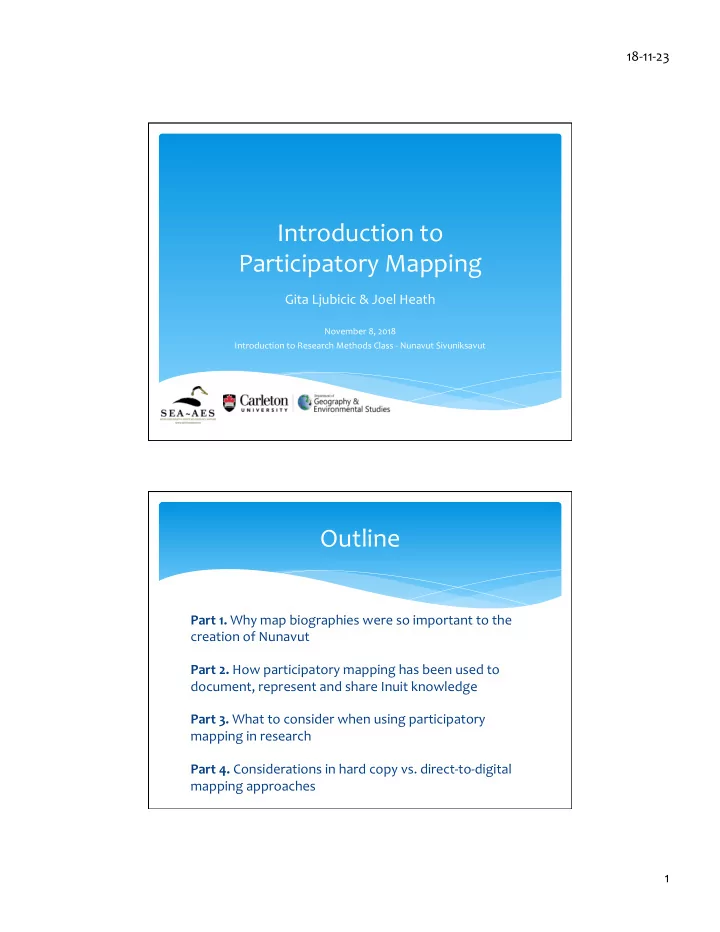

18-11-23 Introduction to Participatory Mapping Gita Ljubicic & Joel Heath November 8, 2018 Introduction to Research Methods Class - Nunavut Sivuniksavut Outline Part 1. Why map biographies were so important to the creation of Nunavut Part 2. How participatory mapping has been used to document, represent and share Inuit knowledge Part 3. What to consider when using participatory mapping in research Part 4. Considerations in hard copy vs. direct-to-digital mapping approaches 1
18-11-23 How do you use maps? Why do you use maps? 2
18-11-23 Why do you use maps? Part 1 Why map biographies were so important to the creation of Nunavut 3
18-11-23 Maps in Traditional Times ∗ Main purposes: 1) for Inuit; 2) for Qallunaat ∗ Content and Style ∗ Relative significance (and distortions) ∗ Natural environment and travel ∗ Landscape representation related to navigation (coastal and land- based differences) ∗ Mapping Proficiency ∗ Phenomenal spatial representation accuracy and locational awareness ∗ All ages, variable experience and skill, many of the best by women ∗ Accuracy of representation by effort not necessarily by distance scale ∗ Emphasis on physical navigational aids (training in awareness and memory) Example traditional maps http://www.paninuittrails.org 4
18-11-23 ∗ From Jones (2004, 65) “The Inuit as Geographers: The case of Eenoolooapik” ∗ Davis Strait/Cumberland Isle ∗ 1839 ∗ Captain Penny’s observations and contributions of Eenoolooapik (mostly on left) Map Biographies ∗ “a map compiled by each hunter interviewed, showing the areas he had hunted, trapped, fished, and camped during his adult life” (ILUOP, 1976, 49) ∗ Indigenous use-and-occupancy mapping (Tobias, 2009) ∗ Evolution along with preparations for land claims negotiations to demonstrate traditional interest in land by showing the extend of both use and occupancy on a map 5
18-11-23 Indigenous use-and-occupancy mapping “Land-use data is essential if the rights of usufruct, which have been recognized throughout history and in virtually every legal system, are to be respected and enjoyed. It should not be surprising then that more and more people are attempting to document land use. Yet I am concerned that so many so unprepared are setting out boldly to make land-use maps. There are few kinds of research which carry with them such tremendous social responsibility and which are so thoroughly difficult to perform effectively. Much can be lost with poorly conceived and poorly executed work. The problem in this case is that the maps, once drawn, tend to last forever. They appear very substantial even when every line on them is wrong or meaningless. When these lines reflect on people’s rights and property for generations they clearly should be most carefully and professionally prepared. ” (Karl E. Francis, quoted in Tobias 2009) Indigenous use-and-occupancy mapping ∗ “Use” – harvesting of resources (collecting of plants, mining earth materials, fishing, hunting, trapping…), travel to engage in use activities ∗ “Occupancy” – evidence of fixed cultural sites (habitations, sacred areas, burial grounds, place names, place-based legends and stories…) ∗ “Traditional” – transmission of customs or beliefs from generation to generation 6
18-11-23 7
18-11-23 Part 2 How participatory mapping has been used to document, represent and share Inuit knowledge Participatory Mapping ∗ A general term often used to: ∗ define a set of approaches and techniques that combines the tools of modern cartography with participatory methods to represent the spatial knowledge of local communities ∗ make visible the association between land and local communities 8
18-11-23 Participatory Mapping A way to: ∗ Help understand, document, ∗ and represent Inuit knowledge of and relationships with the land/ water/ice Evoke memories, spark ∗ discussion (map as mediator) Compile and communicate ∗ information in familiar terms to government officials, scientists, decision-makers Representing land/water surfaces as features on maps 9
18-11-23 Participatory Mapping ∗ Application in Inuit knowledge research context: ∗ Sea ice conditions and dynamics ∗ Wildlife (terrestrial mammals, marine mammals, migratory birds, etc.) ∗ Travel routes/way-finding techniques ∗ Hunting areas/trap lines ∗ Place names ∗ Cultural/archeological sites ∗ Environmental features/impacts ∗ Individual biographies 10
18-11-23 Part 3 What to consider when using participatory mapping in research Representing land/water surfaces using maps ∗ How are maps made? 11
18-11-23 12
18-11-23 Map Projection f 13
18-11-23 Distortions Latitude/Longitude (Lat/Long) Coordinate System 14
18-11-23 Universal Transverse Mercator (UTM) Coordinate System Latitude/Longitude (Lat/Long) National Topographic System (NTS) of Canada Coordinate System Map Scale ∗ “Large scale” ∗ “Small scale” ∗ More detail ∗ Less detail ∗ Smaller area of land ∗ Larger area of land ∗ 1cm = 100m ∗ 1cm = 1,000km ∗ 1:10,000 ∗ 1:100,000,000 15
18-11-23 Map Scale Influence of scale in participatory mapping ∗ Precision – fineness with which interviewee marks data (influence of scale!) ∗ Accuracy – closeness of fit between mapped position and real position on the ground 16
18-11-23 Scale and Measurement ∗ How long is this river? Scale and Measurement ∗ How long is this river? 17
18-11-23 Conducting participatory mapping examples from Pangnirtung, Gjoa Haven ∗ Scale/type of basemap ∗ Feature choices ∗ Registering overlays/maps ∗ Information source ∗ Identification ∗ Comfort level with maps ∗ Colour/thickness of markers ∗ Who is drawing ∗ Accounting for variability ∗ Timeframes ∗ Verifications/updates ∗ Seasons ∗ All in relation to appropriate ∗ Labelling scale/questions for purpose of ∗ Defining features the study Part 4 Considerations in hard copy vs. direct-to-digital mapping approaches 18
18-11-23 Hard copy vs. direct-to-digital mapping http://sikuatlas.ca Hard copy vs. direct-to-digital mapping https://arcticeider.com/map 19
18-11-23 Thank you! Gita Ljubicic, Carleton University Gita.Ljubicic@carleton.ca Joel Heath, The Arctic Eider Society Heath.joel@gmail.com 20
Recommend
More recommend